Latest nematode summer and winter crop rotation results
Author: Kirsty Owen, Tim Clewett and John Thompson: Department of Agriculture, Fisheries and Forestry Queensland | Date: 07 Mar 2014
GRDC code: DAV00128
 Varieties displaying this symbol beside them are protected under the Plant Breeders Rights Act 1994.
Varieties displaying this symbol beside them are protected under the Plant Breeders Rights Act 1994.
Authors
Kirsty Owen, Tim Clewett and John Thompson
Department of Agriculture, Fisheries and Forestry Queensland
Take home messages
Choose tolerant rather than intolerant wheat varieties when P. thornei is present at damaging levels, or risk reducing your yields by 50%.
One resistant crop in sequence may not be enough to decrease damaging populations of P. thornei.
P. thornei survived after a sequence of five resistant crops, but in very low populations.
Management of P. thornei by growing several resistant crops works and populations can be reduced to very low levels. However on-going vigilance by testing soil for nematodes is essential when susceptible crops are planted.
Background
Root-lesion nematodes are microscopic thread-like animals that live in soil and plant roots. Plant roots that are damaged by the nematodes are inefficient at taking-up water and nutrients, causing up to 65% yield loss in intolerant wheat varieties. Pratylenchus thornei is found in approximately 70% of fields in the northern grain region.Management of the root-lesion nematode Pratylenchus thornei requires:
- Growing tolerant wheat varieties so that yields are maximised
- Rotating with two or more successive resistant crops so that populations of the nematodes decrease.
Summer crop rotation trial
Two summer crop rotation trials were planted in adjacent fields in December 2011.
1) The first field had low P. thornei populations (<125/kg soil or 0.125/g soil). The previous cropping history was five resistant crops since 2004 (cotton, maize and sorghum) (Figure 1).
2) The second field had moderate P. thornei populations (range of 2000 to 3000/kg soil (or 2-3/g soil) at 0–90 cm soil depth). The previous cropping history was wheat, sorghum, wheat (Figure 1).
Several cultivars of mungbean, soybean, sunflower, maize and sorghum were planted in each field in December 2011 in a replicated design with sufficient plots to plant wheat cvv. EGA Wylie (tolerant) and Strzelecki
(tolerant) and Strzelecki (intolerant) in 2013. There was also an unplanted bare fallow treatment. After harvest of the summer crops nematode populations were recorded to 120 cm soil depth.
(intolerant) in 2013. There was also an unplanted bare fallow treatment. After harvest of the summer crops nematode populations were recorded to 120 cm soil depth.
Figure 1. Starting populations of Pratylenchus thornei in the summer crop rotation experiments in adjacent fields.
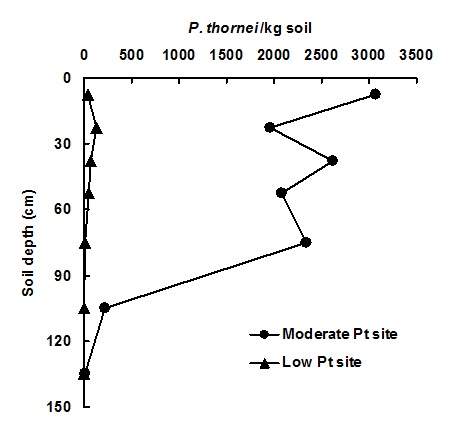
Figure 1 text description: In the low P. thornei site, there was very little P.thornei per kilogram of soil found at all soil depth samples. The highest P. thornei amount found at the Low P. thornei site was at approximately 20cms soil depth at approximately 125 P. thornei/kg soil. At the moderate P. thornei site, the amount per kilogram of soil increased the lower the soil depth became. At approximately 135cm soil depth, there was 0 P. thornei/kg soil and at approximately 10cm soil depth there was approximately 3100 P. thornei/kg soil.
Results
Moderate P. thornei site
P. thornei was found to 90 cm soil depth and populations were greatest at 0–15 cm soil depth (Figure 2).
Populations of P. thornei after growing sorghum, sunflower and maize were similar to bare fallow (range of 2,900–4,500/kg soil at 0–15 cm (Figure 2)). There were no significant differences between varieties within each of these crop species (Figure 3).
In contrast, populations of P. thornei increased after growing mungbean or soybean compared to sunflower, sorghum, maize or clean fallow (Figure 2). There were also differences between varieties of soybean and mungbean (Figure 3).
Soybean cv. Soya791 was moderately resistant (4,800 P. thornei/kg soil at 0–15 cm) and its effect did not differ significantly from the fallow treatment. However, all other soybean varieties were very susceptible. Populations of P. thornei increased 4–6.7 times to 12,000–20,600 P. thornei/kg soil at 0–15 cm (Figure 3).
was moderately resistant (4,800 P. thornei/kg soil at 0–15 cm) and its effect did not differ significantly from the fallow treatment. However, all other soybean varieties were very susceptible. Populations of P. thornei increased 4–6.7 times to 12,000–20,600 P. thornei/kg soil at 0–15 cm (Figure 3).
Mungbean, cv. Emerald
was moderately resistant (3,400 P. thornei/kg soil) and its effect did not differ significantly from the fallow treatment. However, all other mungbean varieties tested were susceptible and P. thornei populations increased 2.2–3.8 times to 6,700–11,700 P. thornei/kg soil at 0–15 cm (Figure 3).
Figure 2. Populations of Pratylenchus thornei increased after growing mungbean and soybean. After growing sunflower, maize and sorghum, populations were similar to the bare fallow (grey line). Means of varieties within each crop are presented for the moderate Pt site.

Figure 2 text description: The amount of P. thornei per kilogram of soil followed very similar patterns with most of the crops (fallow, sunflower, maize, sorghum, mungbean and soybean). They all had a very low P. thornei/kg soil at the highest depth of 105cms. They all increased in P. thornei/kg soil to the lowest soil depth of approximately 10cms. The overall lowest P. thornei/kg soil was seen the soil after growing sunflower. At 10cms soil depth there was approximately 2500 P. thornei/kg soil. The overall highest P. thornei/kg soil was seen in soil after growing Soybean. At 10cm soil depth, there was approximately 12500 P. thornei/kg soil.
Figure 3. After harvest of the summer crops, Pratylenchus thornei was found in highest populations at 0–15 cm soil depth. Varieties of sunflower, maize, sorghum, mungbean cv. Emerald and soybean cv. Soya791
and soybean cv. Soya791 did not differ significantly from the fallow treatment. * indicates significantly higher P. thornei populations than the fallow treatment (P<0.05). Green Dia is mungbean cv. Green Diamond
did not differ significantly from the fallow treatment. * indicates significantly higher P. thornei populations than the fallow treatment (P<0.05). Green Dia is mungbean cv. Green Diamond .
.
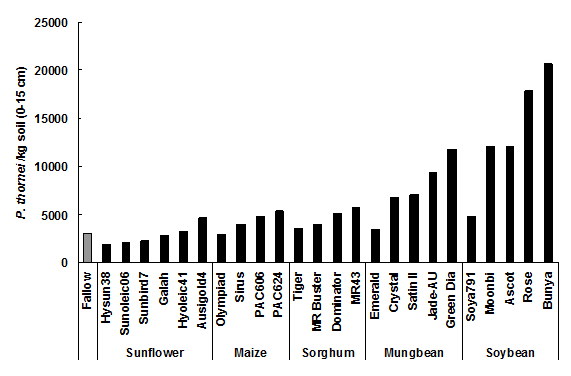
Figure 3 text description: The fallow treatment was approximately 2750 P. thornei/kg soil. Sunflower (Hysun38, Sunoleic06, Sunbird7, Galah, Hyoleic41 and Ausigold4), Maize (olympiad, Sirus, PAC606 and PAC624) and Sorghum (Tiger, MR Buster, Dominator and MR43) all did not reach over approximately 5000 P. thornei/kg soil which was not significantly different from the fallow treatment. Also showing no significant difference from the fallow treatment was Mungbean Emerald which reached approximately 3000 P. thornei/kg soil and Soybean Soya791 which reached approximately 4950 P. thornei/kg soil. All other Mungbean (Crystal, Satin II, Jade-AU and Green Dia) and soybean samples (Moonbi, Ascot, Rose and Bunya) did show a significant difference from the fallow treatment. Mungbean Green Dia reached approximately 12000 P. thornei/kg soil and Soybean Bunya had the highest results of approximately 20000 P. thornei/kg soil.
Low P. thornei site
Pratylenchus thornei was detected to 60 cm soil depth; below that depth populations were very low or zero (Figure 4).
There were no significant differences in P. thornei populations after the different summer crops or the varieties.
Overall, populations increased five times compared to before planting the summer crops, but remained below 250/kg soil (Figure 4).
Figure 4. Pratylenchus thornei populations after harvest of the summer crops at the low Pt site (black line). Mean data for all crops presented; there were no significant differences between crops or varieties. Letters indicate significant differences (P≤0.05) between depth intervals after harvest of the summer crops (black line). The grey line is the pre-plant populations.
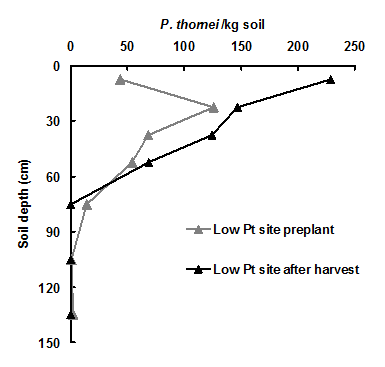
Figure 4 text description: The preplant sample shows a steady increase in the amount of P. thornei/kg soil as the soil depth decreases. However, at approximately 30cms depth the amount of P. thornei drops from approximately 125 P. thornei/kg soil to approximately 45 P. thornei/kg soil. In the after harvest sample, there is no P. thornei in soil depths below 75cms but from 75cms to 10cms the amount of P. thornei increases from 0 to approximately 230 P. thornei/kg soil.
Summer crop biomass and yield
There were no differences in biomass or grain yield of the summer crops between the low and moderate P. thornei sites.
The summer crops used were tolerant to P. thornei so they did not suffer yield loss.
Impact on the next wheat crop
At the site that started with moderate P. thornei populations the yield of the intolerant wheat cv. Strzelecki was reduced by 49% compared the tolerant wheat cv. EGA Wylie
was reduced by 49% compared the tolerant wheat cv. EGA Wylie (1,900 kg/ha after Strzelecki
(1,900 kg/ha after Strzelecki compared to 3,700 kg/ha after EGA Wylie
compared to 3,700 kg/ha after EGA Wylie ). In contrast, at the site that started with low P. thornei populations there was only a 4% difference in yield between cv. Strzelecki
). In contrast, at the site that started with low P. thornei populations there was only a 4% difference in yield between cv. Strzelecki and EGA Wylie
and EGA Wylie (3,600 kg/ha and 3,700 kg/ha respectively). The yield of cv. Strzelecki
(3,600 kg/ha and 3,700 kg/ha respectively). The yield of cv. Strzelecki increased 47%, or 1,700 kg/ha, at the low P. thornei site compared to the moderate P. thornei site (Figure 5).
increased 47%, or 1,700 kg/ha, at the low P. thornei site compared to the moderate P. thornei site (Figure 5).
Figure 5. Yield of the intolerant wheat cv. Strzelecki was reduced by 47% in the experiment that started with moderate P. thornei populations (Mod Pt; 2000–3000/kg soil before the trial started) compared to the low P. thornei site (Low Pt; <125 /kg soil before the trial started). Columns with the same letter are not significantly different (P>0.05). ‘
was reduced by 47% in the experiment that started with moderate P. thornei populations (Mod Pt; 2000–3000/kg soil before the trial started) compared to the low P. thornei site (Low Pt; <125 /kg soil before the trial started). Columns with the same letter are not significantly different (P>0.05). ‘ Varieties displaying this symbol beside them are protected under the Plant Breeders Rights Act 1994.’
Varieties displaying this symbol beside them are protected under the Plant Breeders Rights Act 1994.’
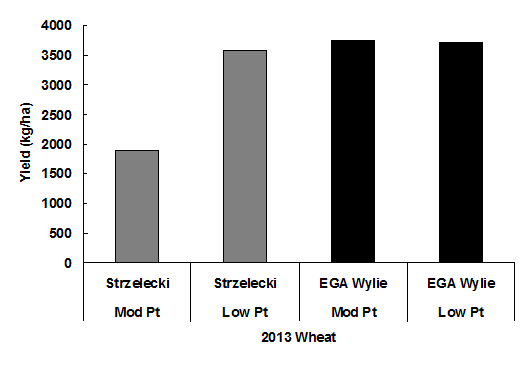
Figure 5 text description: The intolerant wheat Strzelecki showed a difference between the moderate and low P. thornei sites. At the moderate P. thornei site, Strzelecki showed a yield of approximately 1900kg/ha and at the low P. thornei site, Strzelecki showed a yield of approximately 3600kg/ha. The tolerant wheat EGA Wylie did not show much difference between the moderate and low P. thornei site. The moderate P. thornei site showed a yield of approximately 3750kg/ha and the low P. thornei site showed a yield of approximately 3700kg/ha in the EGA Wylie.
Figure 6. Yield of the 2013 intolerant wheat cv. Strzelecki and tolerant cv. EGA Wylie
and tolerant cv. EGA Wylie at the site that started with moderate P. thornei populations (2000–3000/kg soil at 0–90 cm soil depth) before planting the summer crops in 2011-12. Strzelecki columns with the same letter are not significantly different (P>0.05).
at the site that started with moderate P. thornei populations (2000–3000/kg soil at 0–90 cm soil depth) before planting the summer crops in 2011-12. Strzelecki columns with the same letter are not significantly different (P>0.05).
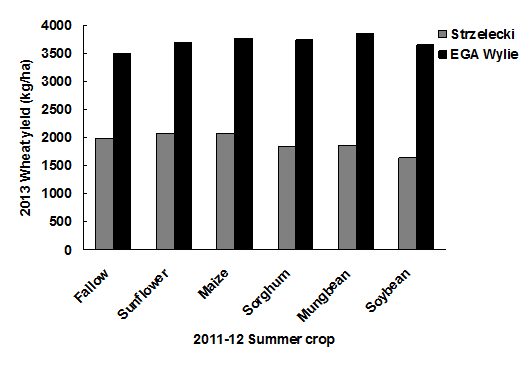
Figure 6 text description: All six sites showed the same pattern of the intolerant Strzelecki having a significantly lower yield than the tolerant EGA Wylie. The site that had the summer crop Maize and sunflower showed the highest Strzelecki yield with both at approximately 2000kg/ha. The site which had the summer crop Soybean showed the lowest Strzelecki yield at approximately 1600kg/ha. The site which had the summer crop Mungbean showed the highest EGA Wylie yield at approximately 3800kg/ha. The site which was the fallow treatment showed the lowest EGA Wylie yield at approximately 3500kg/ha.
Yield of wheat cv. Strzelecki was lowest following soybean (1,600 kg/ha) and greatest following maize and sunflower (2,100 kg/ha). An unexpected result was that there were no significant differences in yield of cv. Strzelecki
was lowest following soybean (1,600 kg/ha) and greatest following maize and sunflower (2,100 kg/ha). An unexpected result was that there were no significant differences in yield of cv. Strzelecki after fallow, sorghum and mungbean. This result may be partly due to dry conditions during the 2011-12 summer and following winter season which limited nematode multiplication, particularly after the susceptible mungbean. Additionally and importantly, the results support that one resistant crop in sequence was not enough to sufficiently reduce populations of P. thornei. Nevertheless, there was a strong negative relationship between populations of P. thornei after the summer crops and yield of the following intolerant wheat cv. Strzelecki
after fallow, sorghum and mungbean. This result may be partly due to dry conditions during the 2011-12 summer and following winter season which limited nematode multiplication, particularly after the susceptible mungbean. Additionally and importantly, the results support that one resistant crop in sequence was not enough to sufficiently reduce populations of P. thornei. Nevertheless, there was a strong negative relationship between populations of P. thornei after the summer crops and yield of the following intolerant wheat cv. Strzelecki . In contrast, there was no relationship between populations of P. thornei and yield of the tolerant wheat cv. EGA Wylie
. In contrast, there was no relationship between populations of P. thornei and yield of the tolerant wheat cv. EGA Wylie (Figure 7) which is an expected result because of the good level of tolerance of EGA Wylie
(Figure 7) which is an expected result because of the good level of tolerance of EGA Wylie to P. thornei.
to P. thornei.
At the low Pt site, there was no relationship between yields of the tolerant and intolerant wheat and populations of P. thornei after growing the summer crops. Populations were below the damage threshold for wheat cv. Strzelecki .
.
Figure 7. There was a strong negative relationship between populations of Pratylenchus thornei after the 2011-12 summer crops and yield of following wheat cv. Strzelecki (P=0.01, n = 6). In contrast there was no significant relationship between yield of cv. EGA Wylie
(P=0.01, n = 6). In contrast there was no significant relationship between yield of cv. EGA Wylie and populations of P. thornei. Data is from the moderate P. thornei site (2000–3000/kg soil at 0–90 cm soil depth before the trial began) and means for 5 summer crops and a fallow treatment are plotted.
and populations of P. thornei. Data is from the moderate P. thornei site (2000–3000/kg soil at 0–90 cm soil depth before the trial began) and means for 5 summer crops and a fallow treatment are plotted.

Figure 7 text description: EGA Wylie did not show a significant relationship between the amount of P. thornei/kg soil and the yield output. The yield stayed consistent for all P. thornei amounts, between approximately 3500kg/ha and approximately 3800kg/ha. Strzelecki showed a negative relationship between the amount of P. thornei in the soil and the yield. The relationships showed that as P. thornei/kg soil increased, the yield decreased. It was found that 78.69% of the decrease in yield was explained by the increase in P. thornei/kg soil. The overall yield was also less for Strzelecki than for EGA Wylie even at low numbers of P. thornei/kg soil. Strzelecki did not reach a yield over approximately 2150kg/ha.
What did we learn from this experiment?
Grow a tolerant wheat variety when populations of P. thornei are at damaging levels or risk losing up to half of your yield.Growing one resistant crop, such as sorghum, maize or sunflower did not provide a quick fix in the field that started with 2,000–3,000 P. thornei/kg soil. Populations of P. thornei did not fall below damaging levels and the next intolerant wheat lost 44–51% in yield compared to a tolerant wheat variety.
P. thornei does not die out completely even after five successive resistant crops. Management of root-lesion nematodes is on-going and requires regular soil tests to monitor nematode populations.
Contact details
Kirsty Owen
Department of Agriculture, Fisheries and Forestry Queensland
Leslie Research Centre
PO Box 2282, Toowoomba, 4350
Ph: 07 4639 8888 07 4639 8888
07 4639 8888  07 4639 8888
07 4639 8888
Email: Kirsty.Owen@daff.qld.gov.au
Reviewed by
Stephen Neate, DAFFQ
GRDC Project Code: DAV00128,
Was this page helpful?
YOUR FEEDBACK
